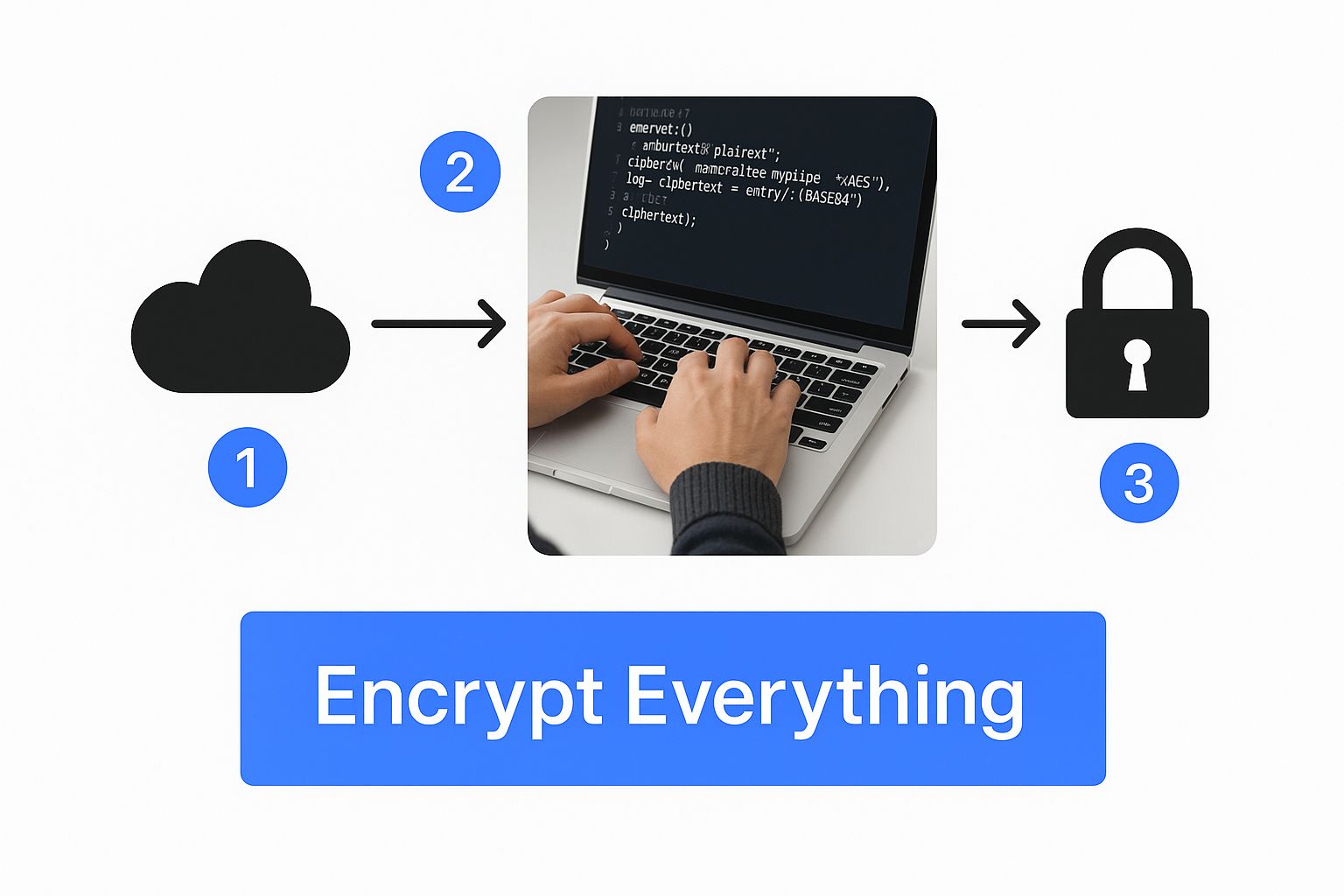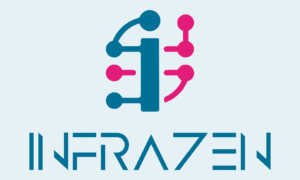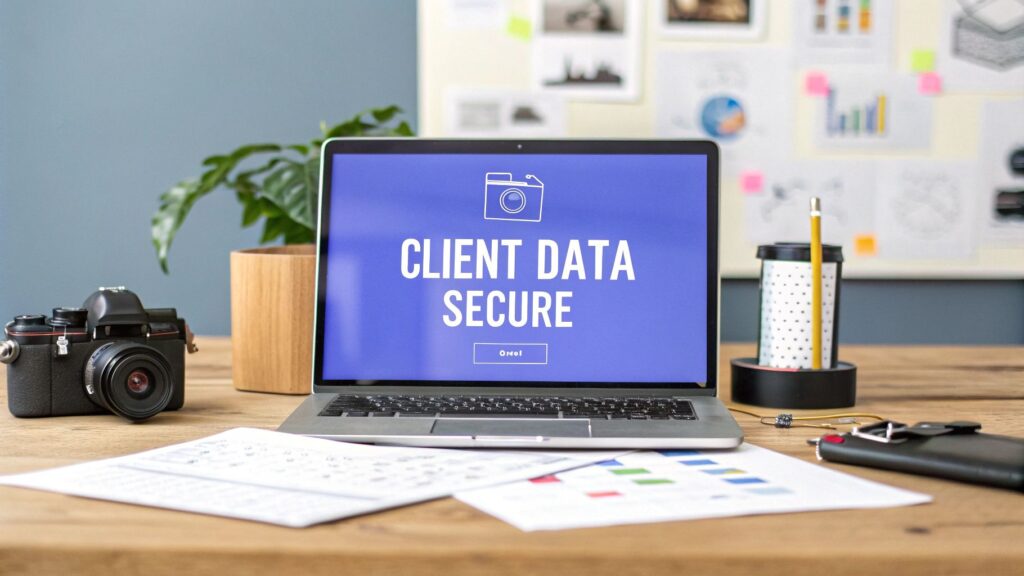Protecting your client's data is more than just a procedural task in the UK; it's the bedrock of the trust you build with them. If you're a creative freelancer or run an agency, you know how much sensitive information passes through your hands. From initial email enquiries to confidential project files, securing that data is essential for your professional reputation and your business's survival.
Why Client Data Protection Is a Creative Imperative

As a creative, you're constantly handling a stream of client information. Think about it: project briefs, contact lists, brand assets, and sometimes very honest feedback. Every piece is a form of personal or commercial data that clients have entrusted to you. How you treat that responsibility speaks volumes.
Getting this right is not about becoming a legal expert overnight. It's about weaving simple, secure habits into your daily workflow. See it as an extension of your client service. You would not deliver a poor design, so why would you offer poor security?
More Than Just a Legal Requirement
While the UK's General Data Protection Regulation (UK GDPR) sets the legal baseline, the real-world consequences of a mistake go far beyond that. A data breach does not just attract the attention of regulators; it can completely shatter the client relationships you have spent years building. Can you imagine having to explain to a long-term client that their confidential launch strategy was leaked because of a weak password or an unsecured file-sharing link?
This is not a distant, hypothetical threat. The latest Cyber Security Breaches Survey is quite sobering. It found that 20% of businesses had to deal with at least one cybercrime incident in the last year, many of which were aimed at stealing client data. You can examine the specifics in the government's official report on cyber security breaches. The consequences are not just financial penalties; they include reputational damage that is incredibly hard to recover from.
To help you understand the core requirements, here’s a quick rundown of the main UK GDPR principles and what they actually mean for your day-to-day creative work.
Core UK GDPR Principles for Your Creative Projects
| Principle | What It Means for Your Creative Business |
|---|---|
| Lawfulness, Fairness, and Transparency | Be upfront about what client data you are collecting and why. Your privacy policy should not be hidden or filled with jargon. |
| Purpose Limitation | Only use the client’s data for the specific project you agreed on. Do not add their email to your marketing list without explicit consent. |
| Data Minimisation | Only collect what you absolutely need. Do you really need their home address for a logo design project? Probably not. |
| Accuracy | Keep client information up to date. If a contact leaves the company, update your records. |
| Storage Limitation | Do not hold data forever. Once a project is finished and the retention period is over, securely delete the files. |
| Integrity and Confidentiality | This is a major one. You must protect data from being lost, destroyed, or accessed by unauthorised people. Think strong passwords and secure cloud storage. |
| Accountability | You are responsible for complying with these principles and must be able to demonstrate that you are. This means having clear processes in place. |
These principles are not there to make your life difficult. They are a framework for building a business that clients can trust implicitly.
Good data protection is a competitive advantage. When clients see you take their privacy seriously, they're more likely to trust you with their most important, high-value projects. That trust leads to stronger, long-term partnerships.
Ultimately, making data security a priority shows you respect your clients and their business. It proves you value their trust just as much as you value their creative brief. This mindset protects them, but it also protects you from financial loss, legal headaches, and the immense stress that follows a security incident. Building a resilient data practice is a fundamental part of running a successful modern creative business.
Building Your Data Protection Framework
Let’s move from theory to practice and build a data protection framework that actually works. This is not about drafting dense legal documents nobody reads; it's about creating clear, repeatable processes that protect both you and your clients. For any busy creative agency or freelancer, this framework has to be practical and easy to scale as you grow.
The first, and most critical, place to start is with a data audit. Think of it as mapping your agency's entire digital footprint. Your goal is to pinpoint every single piece of client data you handle and figure out where it lives. This covers everything from contact details in your email client to large project files sitting in cloud storage.
Start With a Data Audit
A data audit does not need to be a huge, complicated task. Just use a spreadsheet and create a few columns to track everything.
Here’s what you should log:
- Type of Data: What is it, exactly? (e.g., client emails, brand guidelines, project contracts, user research videos).
- Location: Where is it stored? (e.g., a specific Google Drive folder, your laptop's hard drive, a project management tool like Asana).
- Reason for Holding: Why do you have this data? (e.g., for project delivery, invoicing, marketing consent).
- Who Has Access: Which team members, freelancers, or collaborators can see this data?
Going through this exercise will probably be an eye-opening experience, revealing just how much information you’re responsible for. This audit becomes the foundation for everything else, helping you spot potential risks you might have completely overlooked.
Craft a Clear and Simple Privacy Policy
Your privacy policy is a public promise to your clients. It should not be a copy-and-pasted wall of legal text. Instead, write it in plain English that clearly explains how you approach client data protection.
A solid privacy policy for a creative business should concisely cover:
- What data you collect from clients.
- How you use that data to deliver your creative services.
- The steps you take to keep their information secure.
- How long you hold onto it.
Being this transparent builds an incredible amount of trust. It shows you respect your clients' information and have nothing to hide.
A simple, honest privacy policy is far more effective than a lengthy, confusing one. It tells clients you've thought carefully about your responsibilities and are committed to protecting their interests.
One of the most fundamental principles here is securing data both at rest (when it’s stored) and in transit (when it's being sent). A powerful way to visualise this is by looking at the importance of encryption.
This infographic shows exactly why making encryption a default part of your process is so vital.

The image reinforces a key takeaway: encrypting data should not be an afterthought. It needs to be an integral part of your workflow from day one.
Establish Your Internal Policies
Finally, you need to document your internal rules. The most important of these is a data retention schedule. This is simply a policy that dictates how long you keep different types of client data after a project finishes.
For instance, you might decide to keep project files for one year post-completion, but you’re legally required to keep financial records for six years for HMRC.
Documenting this helps you comply with the UK GDPR's 'storage limitation' principle, ensuring you do not keep data indefinitely. By setting and following these simple internal rules, you create a robust framework that becomes second nature, safeguarding your business and reinforcing the trust your clients place in you.
Securing Your Digital and Physical Workspaces
Your creative process is no longer confined to a single studio. It spreads across your office Mac, the laptop at a local coffee shop, and a dozen digital tools in between. Every one of these points is a potential weak spot for client data. Securing these spaces is not about building a digital fortress; it’s about creating smart, consistent habits that protect your client's information, no matter where you're working.
The hard truth is that accidental data leaks are a massive threat. According to the UK's Information Commissioner's Office (ICO), personal data breaches are on the rise, with common causes being phishing, ransomware, and simple human error. These are not just abstract threats; they are real-world incidents that highlight just how vital solid security protocols are. You can discover more about the ICO's data security incident trends on their official site.
This means protecting client data effectively comes down to managing your digital and physical environments with the same level of care.
Bolstering Your Digital Defences
Let’s be honest, your digital workspace is where most client data actually lives. It's the front line of your security efforts, and a few essential practices can make a huge difference.
Start with your passwords. A common mistake among creatives is reusing the same password across multiple platforms. It’s a huge gamble. A single breach on one service could suddenly give an attacker access to everything. The fix is a password manager. These tools are brilliant; they generate and store strong, unique passwords for every site you use, so you only have to remember one master password.
Next, activate two-factor authentication (2FA) everywhere you possibly can. Think of it as a digital deadbolt on your front door. It adds a crucial second layer of security, usually a code sent to your phone, before anyone gets in. Prioritise it for your most critical accounts:
- Email: The gateway to resetting all your other passwords.
- Cloud Storage: Where all your client project files are kept.
- Accounting Software: The home of your sensitive financial information.
Another vital piece of the puzzle is data encryption. Encryption essentially scrambles your data, making it completely unreadable to anyone without the key. Modern operating systems like macOS (FileVault) and Windows (BitLocker) have this built-in, allowing you to encrypt your entire hard drive. This is a lifesaver. If your laptop gets lost or stolen, the client data on it remains secure. For a deeper dive into protecting your digital perimeter, you might find our guide on network security best practices useful.
Key Takeaway: Make encryption your default setting. When you need to send sensitive files to a client, don't just attach them to an email. Use a secure file-sharing service that encrypts data both in transit and at rest, or at the very least, password-protect the files themselves before sending.
Don't Overlook Physical Security
Client data protection goes far beyond your screen. Your physical surroundings, especially if you work in shared spaces or are constantly on the move, demand just as much attention.
It starts with your devices. When you're working in a co-working space or café, never leave your laptop or phone unattended, not even for a second. It's also worth investing in a privacy screen to stop "shoulder surfing," where someone looks over your shoulder to see what you're working on.
Getting rid of old hardware and documents is another area full of risk. An old hard drive or a stack of printed client feedback might seem like junk to you, but it's a potential goldmine for a data thief.
Secure Disposal Checklist
- Hard Drives: Do not just drag files to the trash. Use a disk-wiping utility to permanently erase the data before you recycle the drive. For maximum security, physical destruction is your best option.
- Paper Documents: A simple cross-cut shredder is essential for any documents containing client information, from contracts to creative briefs.
- USB Sticks: These devices are very easy to lose. Always encrypt the data you store on them and make sure you securely wipe them before disposing of them.
By weaving these digital and physical security habits into your daily routine, you build a comprehensive defence system. This proactive approach to client data protection is absolutely fundamental to keeping your clients' trust and protecting the future of your creative business.
Choosing Secure Tools for Creative Collaboration
The software you choose is not just about convenience or cool features; it's a massive part of your client data protection strategy. Every tool you bring into your workflow, from project management apps to file-sharing platforms, becomes a digital guardian of your client’s sensitive information. Choosing them with a security-first mindset is not just good practice—for any UK creative business, it's essential.
Too many creatives are attracted by a slick interface and a long feature list, completely overlooking the security risks beneath the surface. When you sign up for a new tool, you're handing over access to your client's data. It’s vital to look past the marketing and scrutinise how that provider is going to handle such a massive responsibility.
What to Look for in a Provider
Before you even think about clicking "sign up," take a minute to do some research. Any provider that genuinely cares about security will be upfront about its policies. You should not have to hunt for information on their UK GDPR compliance.
Get familiar with their Data Processing Agreement (DPA). This is not just legal filler; it’s a binding contract that spells out exactly how they’ll manage the personal data you give them. Another critical detail is server location. You need to know where your client's data is physically stored, because if it's being transferred outside the UK, it has to meet strict legal safeguards.
A provider’s commitment to security shows in its transparency. If you’re struggling to find details on their encryption methods or UK GDPR stance, that’s a significant red flag. Look for companies that put this information front and centre.
This whole idea is often called 'privacy by design'. It simply means the tool was built from the ground up with data protection as a fundamental feature, not an add-on. The data supports this—businesses that prioritise this approach from the start are far more successful at keeping data safe.
Secure Tool Evaluation Checklist
To help you make smarter choices, here is a quick checklist of the essential security features you should be looking for. Think of this as your vetting process for any new software. It’s about building a tech stack that actively defends your client’s data, not just one that looks good.
| Feature | Why It Matters | Example Tools |
|---|---|---|
| End-to-End Encryption | This ensures your files are secure while being stored (at rest) and while being sent (in transit). No one can snoop on them. | Tresorit, Sync.com |
| UK GDPR Compliance | Confirms the provider meets UK legal standards for data protection, which is essential for your own compliance. | Most reputable cloud services will have a dedicated compliance page. |
| Access Controls & Permissions | Lets you decide who sees what. You can give clients or team members access only to the files and folders they need. | Google Drive, Dropbox for Business |
| Two-Factor Authentication (2FA) | Adds a crucial second layer of security. Even if a password gets stolen, this stops intruders. | Trello, Asana, Slack |
By taking the time to properly vet your tools, you turn your software from a potential risk into a fortress for your client’s information. It's a professional move that builds the kind of trust that great, long-lasting client relationships are built on.
Managing Contracts and Responding to Data Breaches

Let’s be honest: solid client relationships are built on trust, and that absolutely includes how you handle their data. Addressing data protection in your contracts is not about adding intimidating legal jargon. It's about professionally and clearly defining how you'll look after their information right from the start.
A simple clause in your contract or statement of work can make a world of difference. It lays out your commitments, reassures the client, and makes responsibilities crystal clear before a single file is ever shared.
This kind of transparency is not just about building trust—it's a critical part of your own compliance. Just as important is knowing exactly what to do if the worst happens. A data breach can feel completely overwhelming, but having a plan ready turns panic into a structured, professional response.
Weaving Data Protection Into Your Contracts
You do not need a solicitor on retainer to draft overly complex clauses. For most creative projects, a straightforward section in your existing agreement is all it takes.
Your contract should briefly outline:
- Confidentiality: A clear commitment to keep all client information and project materials private.
- Data Use: A simple statement confirming you'll only use their data to complete the agreed-upon project.
- Data Return or Deletion: Clarification on what happens to their files once the project is finished and the final invoice is paid.
Taking this simple step shows you take your responsibilities as a data processor seriously. It immediately positions you as a secure, reliable partner, which can be a huge differentiator in a crowded market.
A data breach response plan is like having a fire extinguisher in the studio. You hope you never have to use it, but you would be foolish to operate without one. It’s an essential tool for damage control, protecting your reputation and your clients.
Having a response ready is not just good practice; it's a legal requirement. The financial and reputational fallout from mishandling a breach can be severe. Just look at the £2.31 million penalty given to 23andMe after a major breach—it shows how seriously the UK's Information Commissioner's Office (ICO) takes these failures.
Your Action Plan for a Data Breach
If you even suspect a breach has occurred, you need to move fast. Under UK GDPR, you have just 72 hours from the moment you become aware of a breach to report it to the ICO, provided it poses a risk to individuals' rights and freedoms.
Here’s a simple checklist for solo creatives and small teams to follow:
First, identify and contain the problem. The immediate priority is to confirm a breach has actually happened. If it has, take steps to stop it from getting worse. This could mean changing all your passwords, taking a system offline temporarily, or revoking access for a compromised account.
Next, assess the risk. You need to figure out what data was affected and how serious the potential impact is. Was sensitive client information accessed, or was it a minor internal issue? A formal evaluation helps, and our cybersecurity risk assessment template is a great place to start.
Then, notify the ICO. If the breach is likely to result in a risk to people’s rights, you are legally obligated to report it to the ICO within that 72-hour window. Be ready to explain what happened, what data is involved, and what you’re doing about it.
Finally, inform your clients. If the breach is high-risk, you must also tell the individuals or clients affected without unnecessary delay. Be honest, be clear, and explain the steps they can take to protect themselves.
This structured approach helps you meet your legal obligations while navigating a tough situation with professionalism, which will minimise stress and limit the damage.
Common Data Protection Questions for Creatives
Even with a solid framework in place, questions about client data always come up in the day-to-day work of running a creative business. It's one thing to have a policy, but another to know what to do in a specific, real-world situation.
Think of this as your go-to guide for those tricky moments. We’ve pulled together the most frequent queries we hear from UK-based freelancers and studios to give you clear, practical answers without you having to go through dense legal text.
Do I Need a Data Protection Officer?
For most small creative studios and freelancers in the UK, the short answer is no. You're not legally required to appoint a formal Data Protection Officer (DPO).
Under UK GDPR, a DPO is only mandatory if you're a public authority or if your core business involves large-scale, systematic monitoring of people. That rarely applies to creative work. But here’s the important part: you are still 100% responsible for data protection.
It’s just good practice to make one person in your team the official point of contact for data security—even if that person is you. This ensures someone is always keeping an eye on things and nothing is missed.
What’s the Difference Between a Data Controller and a Processor?
Getting this right is absolutely crucial for any creative agency. It defines who is responsible for what.
In almost all project-based work, your client is the data controller. They are the ones who decide why and how personal data should be processed. For example, they’re the ones who decide to launch a marketing campaign using their customer email list.
As the creative agency or freelancer carrying out their instructions, you are the data processor. Your role is to handle the data on their behalf, for the specific purpose they’ve defined. This relationship must be formalised in a contract, often called a Data Processing Agreement (DPA), which clearly sets out your responsibilities.
It's important to remember that if you collect data for your own business purposes, such as an email list for your studio's newsletter, you become the data controller for that specific set of information.
How Long Should I Keep Client Files?
This is a big one. The UK GDPR's 'storage limitation' principle is clear: you should not keep personal data for longer than is strictly necessary. But what does "necessary" actually mean? There's no single timeline that fits every situation.
The best way to handle this is to create a simple, documented data retention policy. Here’s a sensible approach:
- Project Files: A period of 6-12 months after project completion is usually reasonable. This gives you enough time to handle any follow-up questions or last-minute requests from the client without holding onto their data indefinitely.
- Financial Records: For anything related to finance, like invoices and payment records, UK law is very specific. You’re legally required to keep these for at least six years for tax purposes.
The key is to document your chosen timelines and, just as importantly, to have a process for securely deleting the data once that time is up. Make sure you outline your policy in your client contracts so everyone is on the same page from the start.
For more practical tips on keeping your business secure, check out these 5 critical cybersecurity measures for small businesses in 2025.
At InfraZen Ltd, we handle the technical complexities so you can focus on your creative work. We provide specialised IT support and cybersecurity for creative agencies, ensuring your client data is protected and your systems run smoothly. Discover how we help creatives work without interruption.

